warning LOTUS ELISE 2005 Repair Manual
[x] Cancel search | Manufacturer: LOTUS, Model Year: 2005, Model line: ELISE, Model: LOTUS ELISE 2005Pages: 205, PDF Size: 4.51 MB
Page 123 of 205
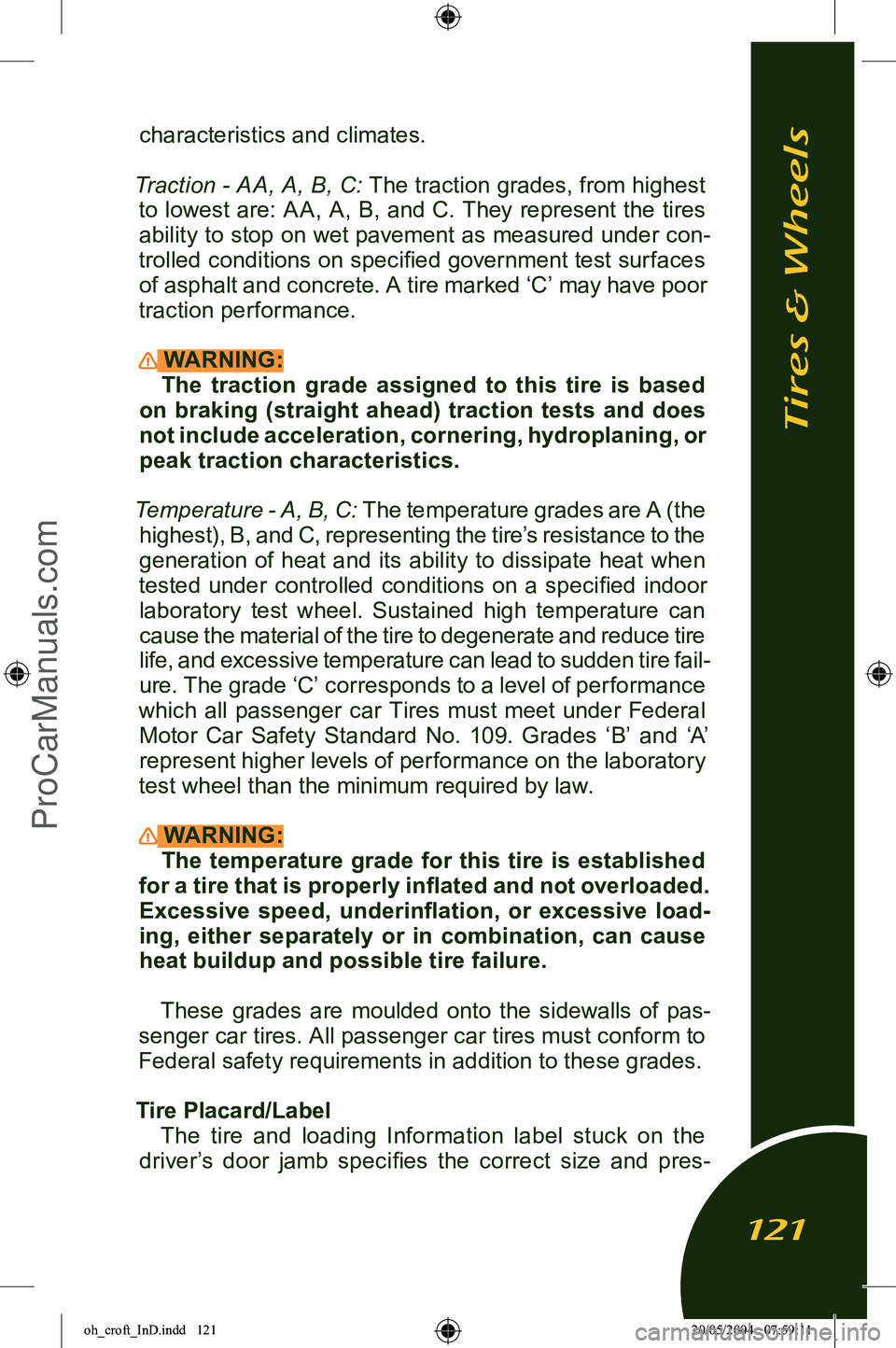
characteristics and climates.
Traction - AA, A, B, C: The traction grades, from highest to lowest are: A A, A, B, and C. They represent the tires ability to stop on wet pavement as measured under con
-
trolled conditions on specified government test surfaces of asphalt and concrete. A tire marked ‘C’ may have poor
traction performance.
WARNING: The traction grade assigned to this tire is based
on braking (straight ahead) traction tests and does
not include acceleration, cornering, hydroplaning, or
peak traction characteristics.
Temperature - A, B, C: The temperature grades are A (the highest), B, and C, representing the tire’s resistance to the generation of heat and its ability to dissipate heat when
tested under controlled conditions on a specified indoor laboratory test wheel. Sustained high temperature can cause the material of the tire to degenerate and reduce tire
life, and excessive temperature can lead to sudden tire fail
-
ure. The grade ‘C’ corresponds to a level of performance
which all passenger car Tires must meet under Federal Motor Car Safety Standard No. 109. Grades ‘B’ and ‘A’ represent higher levels of performance on the laboratory
test wheel than the minimum required by law.
WARNING: The temperature grade for this tire is established
for a tire that is properly inflated and not overloaded. Excessive speed, underinflation, or excessive load
-
ing, either separately or in combination, can cause
heat buildup and possible tire failure.
These grades are moulded onto the sidewalls of pas
-
senger car tires. All passenger car tires must conform to Federal safety requirements in addition to these grades.
Tire Placard/Label The tire and loading Information label stuck on the
driver’s door jamb specifies the correct size and pres
-
Tires & Wheels
121
oh_croft_InD.indd 12120/05/2004 07:59:11ProCarManuals.com
Page 124 of 205

sure of tires to be used on the Elise. It also specifies the total weight the car can carry, called the car capacity
weight. This includes the weight of driver, passenger and luggage. Also to be found on the driver’s door jamb is the Cer
-
tification label (‘Manufactured by Lotus Cars Ltd.’) which stipulates the Gross Car Weight Rating (GV WR). The
GVWR includes the weight of the car, occupants, fuel and luggage. Never exceed the GVWR or the Gross Axle
Weight Rating (GAWR) for either the front or rear axle. The maximum load which may be carried in the rear luggage compartment is 110 lb (50 kg). Note that the Elise is not designed to tow a trailer, and no such attempt should be
made.
WARNING: Do not exceed the GVWR, or front or rear GAWR.
Exceeding these limits may cause unstable handling or car or tire damage which could cause a crash
in which you or others could be seriously injured or killed.
The Elise should never be used to tow a
trailer.
Federal Motor Car Safety Standards require Lotus to in
-
clude the following verbatim statement in this handbook:
Steps for Determining Correct Load Limit:
1) Locate the statement “The combined weight of occupants and cargo should never exceed XXX pounds”
on your car’s placard.
2) Determine the combined weight of the driver and pas
-
senger that will be riding in your car.
3) Subtract the combined weight of the driver and pas
-
senger from XXX kilograms, or XXX pounds.
4) The resulting figure equals the available amount of cargo and luggage load capacity. For example, if the
“XXX” amount equals 1400 lbs. and there will be five 150 lb. passengers in your car, the amount of available cargo and luggage load capacity is 650 lbs. (1400 - 750
(5 x 150) = 650 lbs.)
Note: Maximum load to be carried in the Elise rear lug-
gage compartment is 110 lb (50 kg).
Tires & Wheels
122
oh_croft_InD.indd 12220/05/2004 07:59:11ProCarManuals.com
Page 125 of 205
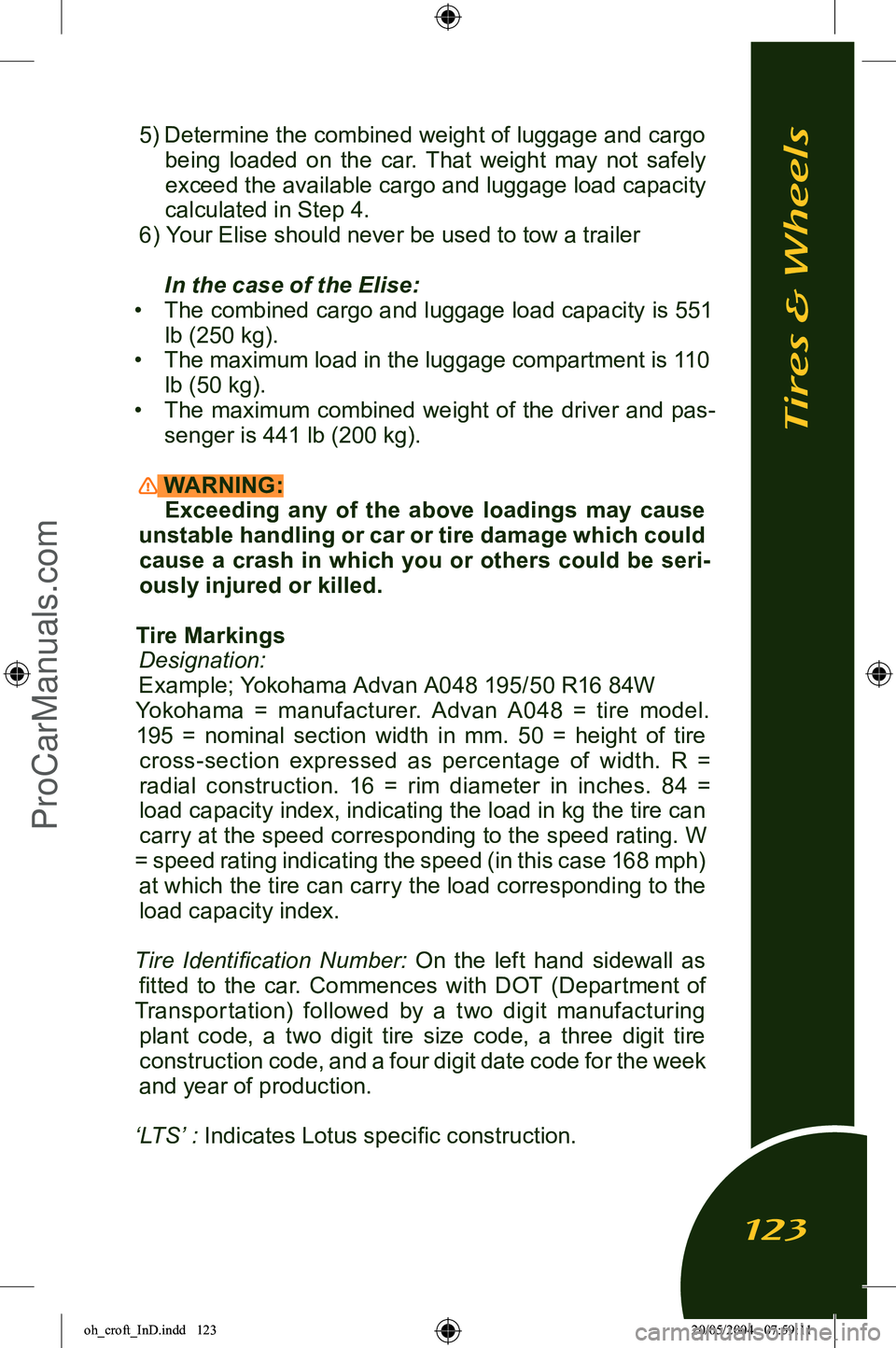
5) Determine the combined weight of luggage and cargo being loaded on the car. That weight may not safely exceed the available cargo and luggage load capacity
calculated in Step 4.
6) Your Elise should never be used to tow a trailer
In the case of the Elise:
• The combined cargo and luggage load capacity is 551
lb (250 kg).
• The maximum load in the luggage compartment is 110
lb (50 kg).
• The maximum combined weight of the driver and pas
-
senger is 441 lb (200 kg).
WARNING: Exceeding any of the above loadings may cause
unstable handling or car or tire damage which could cause a crash in which you or others could be seri
-
ously injured or killed.
Tire Markings Designation:Example; Yokohama Advan A048 195/50 R16 84W
Yokohama = manufacturer. Advan A048 = tire model. 195 = nominal section width in mm. 50 = height of tire cross-section expressed as percentage of width. R =
radial construction. 16 = rim diameter in inches. 84 =
load capacity index, indicating the load in kg the tire can carry at the speed corresponding to the speed rating. W
= speed rating indicating the speed (in this case 168 mph) at which the tire can carry the load corresponding to the load capacity index.
Tire Identification Number: On the left hand sidewall as fitted to the car. Commences with DOT (Department of
Transpor tation) followed by a two digit manufacturing plant code, a two digit tire size code, a three digit tire construction code, and a four digit date code for the week
and year of production.
‘LTS’
: Indicates Lotus specific construction.
Tires & Wheels
123
oh_croft_InD.indd 12320/05/2004 07:59:11ProCarManuals.com
Page 126 of 205
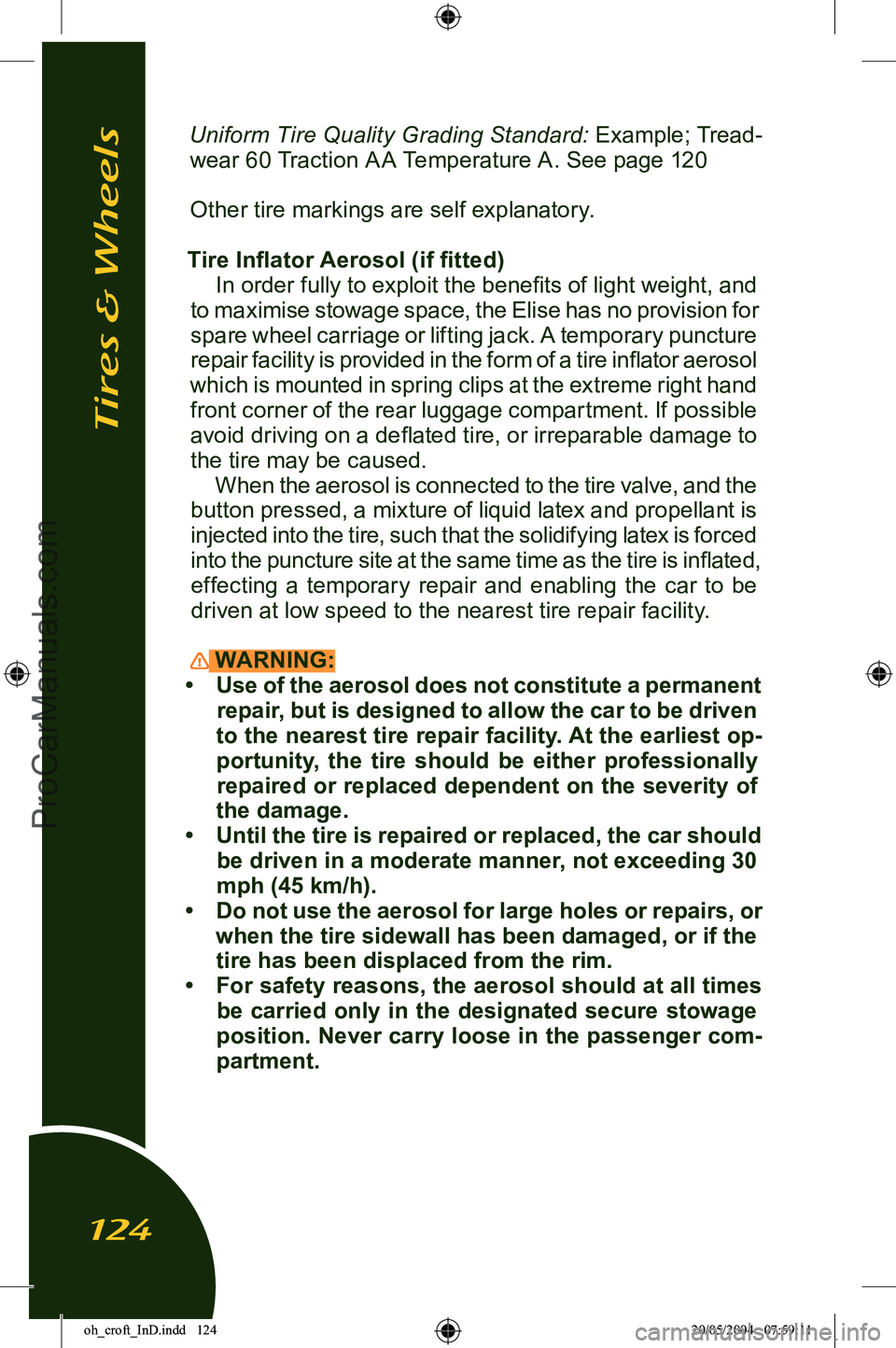
Uniform Tire Quality Grading Standard: Example; Tread-
wear 60 Traction A A Temperature A. See page 120
Other tire markings are self explanatory.
Tire Inflator Aerosol (if fitted) In order fully to exploit the benefits of light weight, and
to maximise stowage space, the Elise has no provision for spare wheel carriage or lifting jack. A temporary puncture
repair facility is provided in the form of a tire inflator aerosol
which is mounted in spring clips at the extreme right hand front corner of the rear luggage compartment. If possible avoid driving on a deflated tire, or irreparable damage to
the tire may be caused. When the aerosol is connected to the tire valve, and the
button pressed, a mixture of liquid latex and propellant is
injected into the tire, such that the solidifying latex is forced
into the puncture site at the same time as the tire is inflated, effecting a temporary repair and enabling the car to be driven at low speed to the nearest tire repair facility.
WARNING:
• Use of the aerosol does not constitute a permanent repair, but is designed to allow the car to be driven
to the nearest tire repair facility. At the earliest op
-
portunity, the tire should be either professionally repaired or replaced dependent on the severity of
the damage.
• Until the tire is repaired or replaced, the car should be driven in a moderate manner, not exceeding 30
mph (45 km/h).
• Do not use the aerosol for large holes or repairs, or when the tire sidewall has been damaged, or if the
tire has been displaced from the rim.
• For safety reasons, the aerosol should at all times be carried only in the designated secure stowage
position. Never carry loose in the passenger com
-
partment.
Tires & Wheels
124
oh_croft_InD.indd 12420/05/2004 07:59:11ProCarManuals.com
Page 128 of 205

WheelsEnsure that only original equipment, or Lotus approved wheel
and tire combinations are fitted. After the car has been used
on track, or in competition conditions, the wheels should be removed and thoroughly inspected for damage.
WARNING: After striking a pothole or kerb, the wheels should be
removed and the wheel and tire thoroughly inspected for
damage. Renew the wheel and /or tire if necessary. Safety
considerations should always be paramount and new parts
fitted in any cases of doubt.
Wheel Bolts The wheel bolts used on the Elise are of a special design to
suit the small diameter fixing tunnels in the wheel centres. The bolts have a 10 spline socket head, for which a special extension
tool is supplied with the car. A 17mm a/f deep socket and 1/2
inch square drive wrench should be applied to the extension tool,
with a tightening torque of 77 lbf.ft (105 Nm) required. To protect against wheel theft, one of the four bolts securing
each wheel is key coded, and requires a corresponding coded
socket wrench and 1/2 inch square drive extension. Rotate the coded socket until full engagement with the bolt head is ensured and take care to maintain the extension tool perpendicular to
the wheel face before applying release torque.
NOTICE: It is not recommended to use hammer action air tools on the coded bolts - use only manual tools.
Both the standard extension and coded socket tools are
stowed in the car tool kit, and should remain with the car at all
times to ensure that servicing may be performed. The key code
included in the tool kit should be recorded and kept safely with
the car documents, in case a replacement socket tool needs
to be ordered.
Wheel Alignment and Tire Balance The wheels on your car were aligned and balanced carefully
during the manufacture of your car to give you the longest tire
life and best overall performance.
Tires & Wheels
126
oh_croft_InD.indd 12620/05/2004 07:59:12ProCarManuals.com
Page 129 of 205
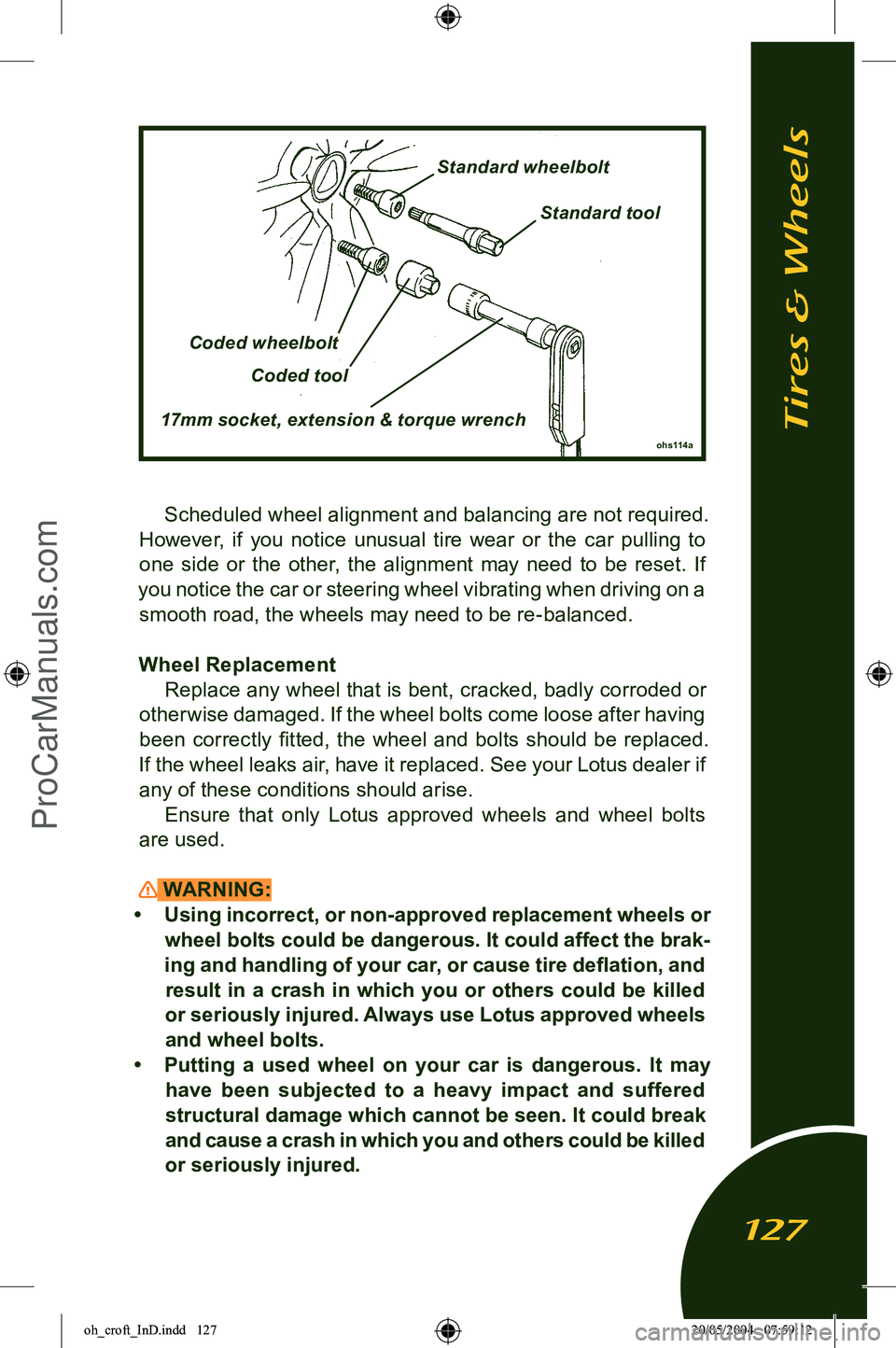
Scheduled wheel alignment and balancing are not required.
However, if you notice unusual tire wear or the car pulling to one side or the other, the alignment may need to be reset. If
you notice the car or steering wheel vibrating when driving on a smooth road, the wheels may need to be re-balanced.
Wheel Replacement Replace any wheel that is bent, cracked, badly corroded or
otherwise damaged. If the wheel bolts come loose after having been correctly fitted, the wheel and bolts should be replaced.
If the wheel leaks air, have it replaced. See your Lotus dealer if any of these conditions should arise.
Ensure that only Lotus approved wheels and wheel bolts
are used.
WARNING:
• Using incorrect, or non-approved replacement wheels or wheel bolts could be dangerous. It could affect the brak
-
ing and handling of your car, or cause tire deflation, and result in a crash in which you or others could be killed
or seriously injured. Always use Lotus approved wheels
and wheel bolts.
• Putting a used wheel on your car is dangerous. It may have been subjected to a heavy impact and suffered
structural damage which cannot be seen. It could break
and cause a crash in which you and others could be killed
or seriously injured.
ohs114a
Coded wheelbolt
Coded tool
17mm socket, extension & torque wrench
Standard wheelbolt
Standard tool
Tires & Wheels
127
oh_croft_InD.indd 12720/05/2004 07:59:12ProCarManuals.com
Page 130 of 205

NOTICE: Using incorrect wheel/tire equipment can also cause problems with wheel bearing life, brake cooling, speedo and
odometer calibration, headlamp aim, ground clearance and tire
clearance to the body.
WARNING: Dirt or corrosion on a wheel or hub mounting flange or
wheel bolts, can result in the wheel bolts coming loose.
The wheel could come off and cause a crash in which you and others could be killed or seriously injured. Thoroughly
clean these components or fit new Lotus approved replace
-
ments before fitting a wheel. Never use oil or grease on the wheel bolts or hub threads.
If you do, the bolts could come loose and the wheel could
come off, causing a crash in which you and others could be killed or seriously injured. Using incorrect wheel bolts, or the wrong tightening
torque could cause the bolts to come loose and the wheel to come off, resulting in a crash in which you and others could be killed or seriously injured. Use only the correct Lotus
approved wheel bolts tightened to 77 lbf.ft (105 Nm).
NOTICE: Improperly tightened wheel bolts, or dirt on the wheel
to hub mounting face can cause brake pulsation and judder, and damage the brake discs. To avoid expensive brake repairs,
ensure complete cleanliness on assembly and tighten the wheel
bolts in a diagonal sequence to the correct torque.
For advice and information on lifting the Elise, refer to ‘Lifting
Points’ on page 148Tires & Wheels
128
oh_croft_InD.indd 12820/05/2004 07:59:12ProCarManuals.com
Page 131 of 205
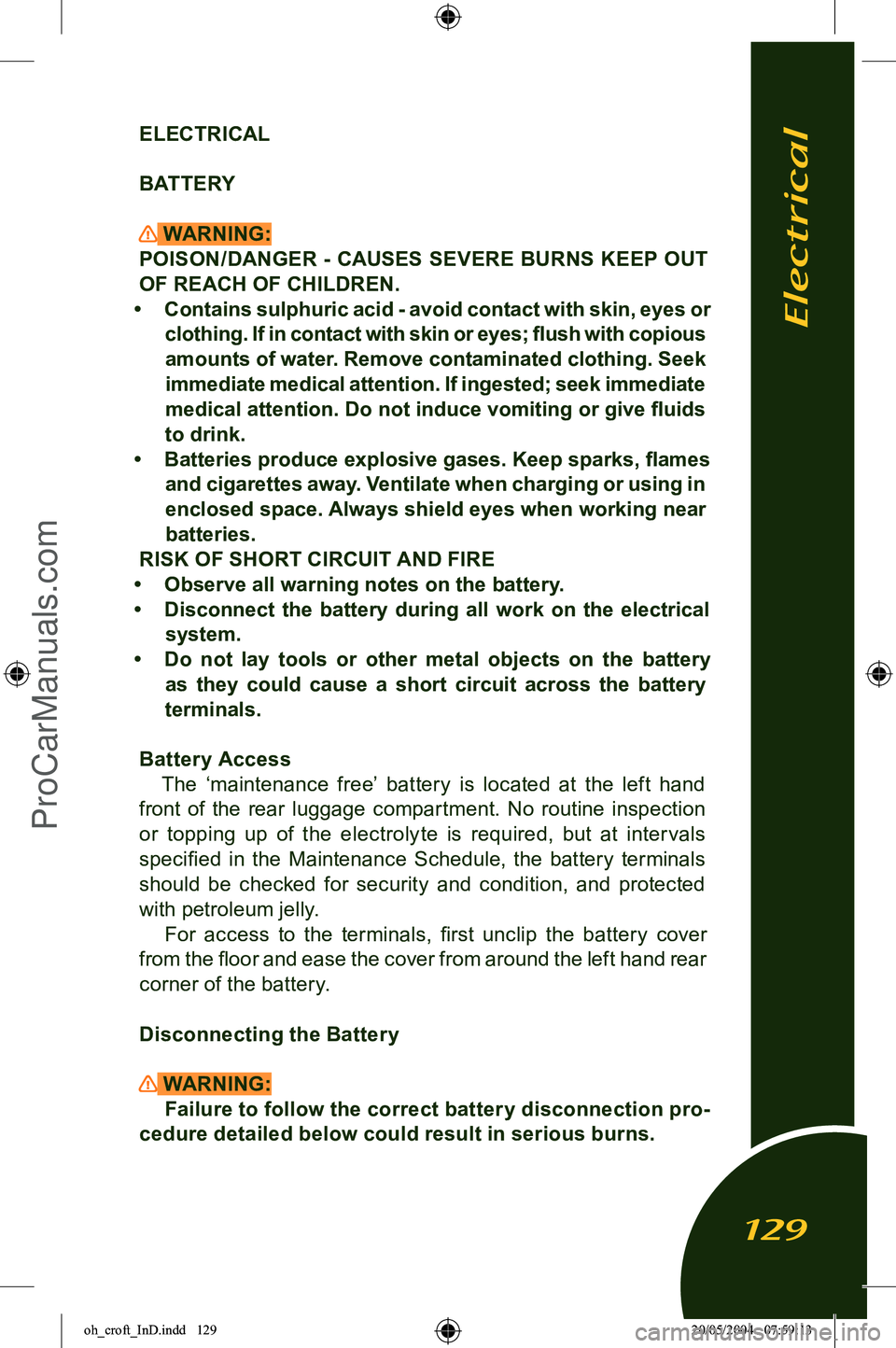
ELECTRICAL
BATTERY
WARNING:
POISON/DANGER - CAUSES SEVERE BURNS KEEP OUT
OF REACH OF CHILDREN.
• Contains sulphuric acid - avoid contact with skin, eyes or clothing. If in contact with skin or eyes; flush with copious amounts of water. Remove contaminated clothing. Seek
immediate medical attention. If ingested; seek immediate
medical attention. Do not induce vomiting or give fluids
to drink.
• Batteries produce explosive gases. Keep sparks, flames and cigarettes away. Ventilate when charging or using in
enclosed space. Always shield eyes when working near
batteries.
RISK OF SHORT CIRCUIT AND FIRE
• Observe all warning notes on the battery.
• Disconnect the battery during all work on the electrical system.
• Do not lay tools or other metal objects on the battery as they could cause a short circuit across the battery
terminals.
Battery Access The ‘maintenance free’ battery is located at the left hand
front of the rear luggage compartment. No routine inspection or topping up of the electrolyte is required, but at inter vals
specified in the Maintenance Schedule, the battery terminals
should be checked for security and condition, and protected
with petroleum jelly. For access to the terminals, first unclip the battery cover
from the floor and ease the cover from around the left hand rear corner of the battery.
Disconnecting the Battery
WARNING: Failure to follow the correct battery disconnection pro
-
cedure detailed below could result in serious burns.
Electrical
129
oh_croft_InD.indd 12920/05/2004 07:59:13ProCarManuals.com
Page 132 of 205
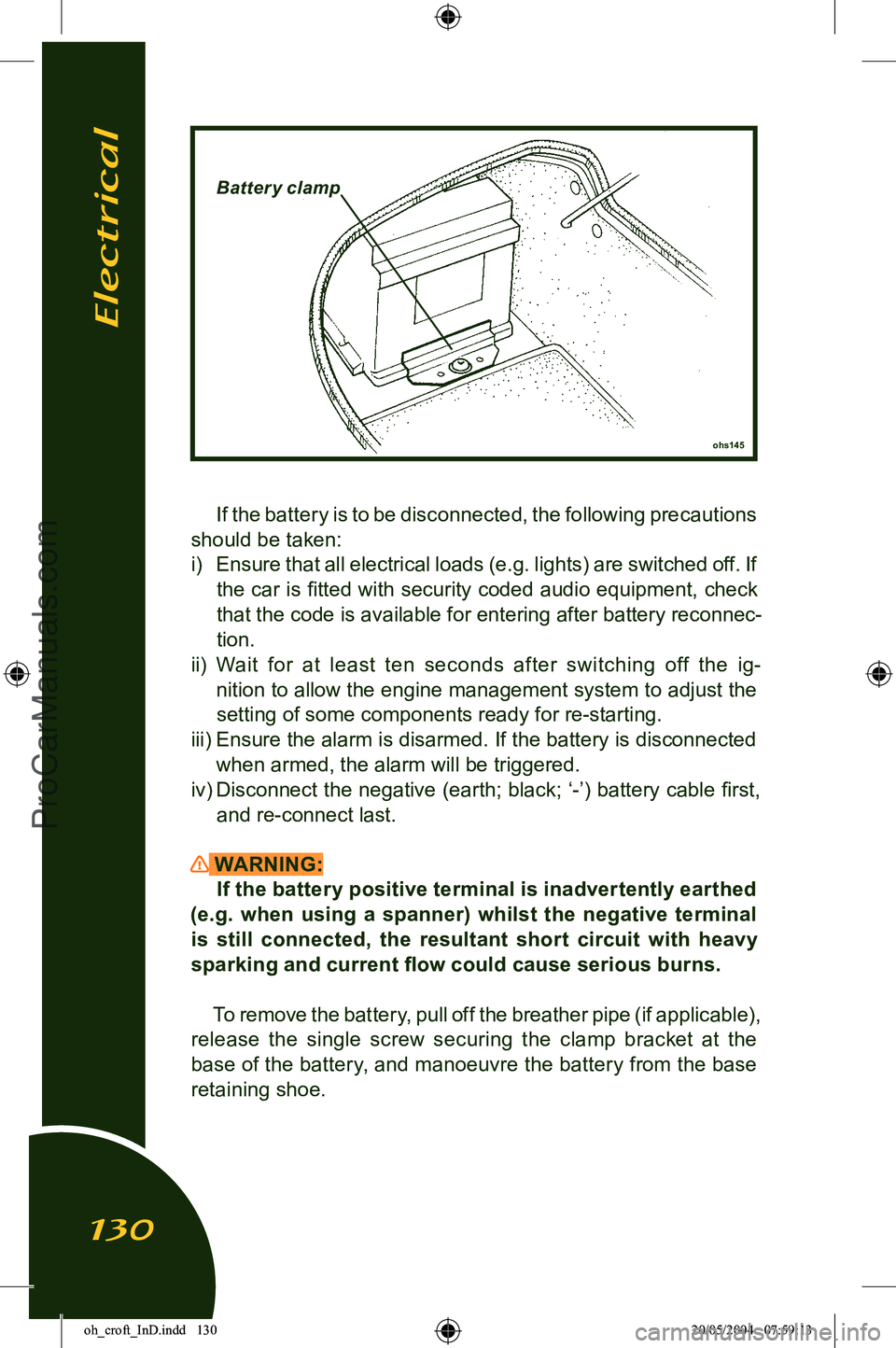
If the battery is to be disconnected, the following precautions
should be taken: i) Ensure that all electrical loads (e.g. lights) are switched off. If
the car is fitted with security coded audio equipment, check
that the code is available for entering after battery reconnec
-
tion.
ii) Wait for at least ten seconds after switching off the ig-
nition to allow the engine management system to adjust the
setting of some components ready for re-starting.
iii) Ensure the alarm is disarmed. If the battery is disconnected
when armed, the alarm will be triggered.
iv) Disconnect the
negative (earth; black; ‘-’) battery cable first,
and re-connect last.
WARNING:
If the battery positive terminal is inadvertently earthed
(e.g. when using a spanner) whilst the negative terminal
is still connected, the resultant short circuit with heavy sparking and current flow could cause serious burns.
To remove the battery, pull off the breather pipe (if applicable),
release the single screw securing the clamp bracket at the
base of the battery, and manoeuvre the battery from the base
retaining shoe.
ohs145
Batter y clamp
Electrical
130
oh_croft_InD.indd 13020/05/2004 07:59:13ProCarManuals.com
Page 133 of 205
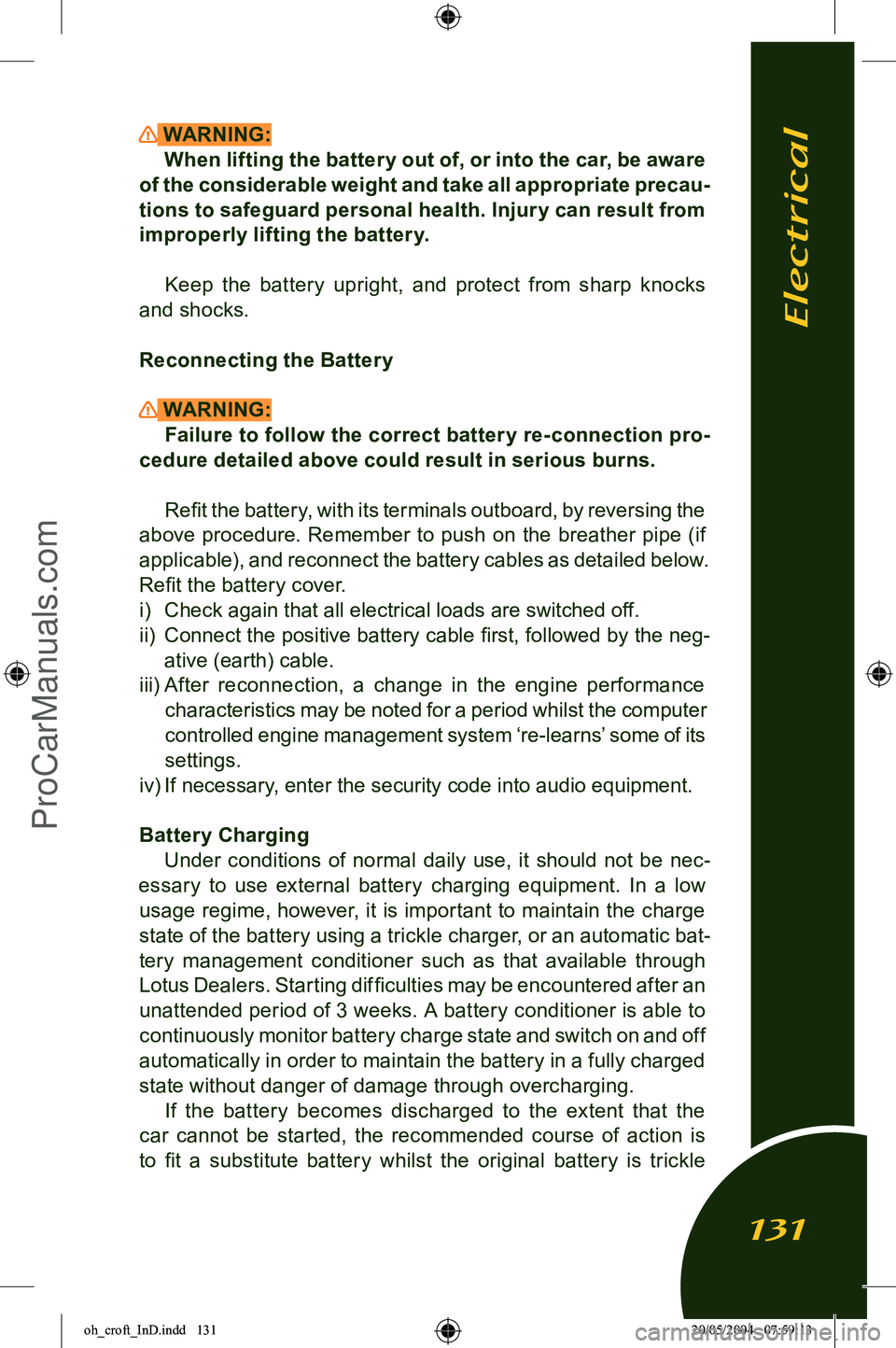
WARNING:When lifting the battery out of, or into the car, be aware
of the considerable weight and take all appropriate precau
-
tions to safeguard personal health. Injury can result from improperly lifting the battery.
Keep the battery upright, and protect from sharp knocks
and shocks.
Reconnecting the Battery
WARNING: Failure to follow the correct battery re- connection pro
-
cedure detailed above could result in serious burns.
Refit the battery, with its terminals outboard, by reversing the
above procedure. Remember to push on the breather pipe (if
applicable), and reconnect the battery cables as detailed below.
Refit the battery cover.
i) Check again that all electrical loads are switched off.
ii) Connect the positive battery cable first, followed by the neg
-
ative (earth) cable.
iii) After reconnection, a change in the engine performance
characteristics may be noted for a period whilst the computer
controlled engine management system ‘re-learns’ some of its
settings.
iv) If necessary, enter the security code into audio equipment.
Battery Charging Under conditions of normal daily use, it should not be nec
-
essary to use external battery charging equipment. In a low usage regime, however, it is important to maintain the charge
state of the battery using a trickle charger, or an automatic bat
-
tery management conditioner such as that available through Lotus Dealers. Starting difficulties may be encountered after an
unattended period of 3 weeks. A battery conditioner is able to continuously monitor battery charge state and switch on and off automatically in order to maintain the battery in a fully charged
state without danger of damage through overcharging.
If the battery becomes discharged to the extent that the
car cannot be started, the recommended course of action is
to fit a substitute battery whilst the original battery is trickle
Electrical
131
oh_croft_InD.indd 13120/05/2004 07:59:13ProCarManuals.com